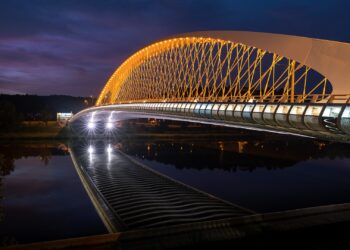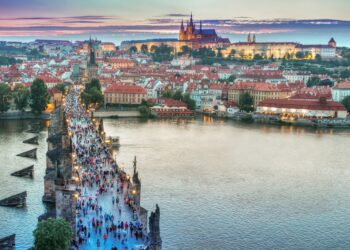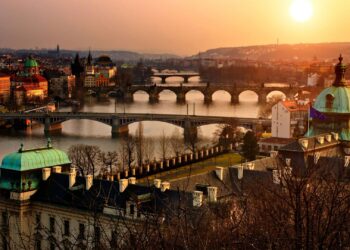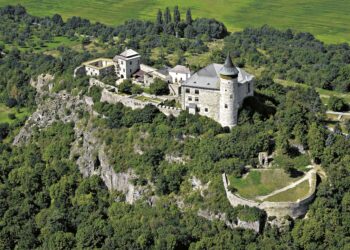FAMOUS CZECHS
Even though Czechia is just a mid-sized country in both land area and population, it has been home to a large number of important contributors to science and European culture and history. Rather than trying to put together an exhausting or even comprehensive list, the following will just touch on a few of these important figures.
We have all gone to school and most of us have been exposed to religion, but many might not know the names John Huss (1369-1415) and John Amos Comenius (1592-1670). Yes, they lived a long time ago, but the former was a leader of the religious reformation that led to Protestantism, and the latter the “Teacher of the Nations”, a scholar who was instrumental in laying the foundations of the public education systems as we know them today in both Europe and the Americas.
When asked to name some important Czechs, people might think of important political figures such as Tomáš Garrigue Masaryk and Václav Havel and famous musicians such as Dvořák, Janáček, and Smetana.
In politics, Tomáš Garrigue Masaryk was one of the founders of Czechoslovakia after the end of World War I. Václav Havel was a leading figure in the history of modern Czechia. Classical music fans all know that the names Dvořák, Janáček and Smetana belong to important 19th century Czech composers. And, for those who are interested in sports, there is the young Petr Čech, whom some credit as the best football (soccer) goalie in the world, and former ice hockey superstar Dominik Hašek.
In addition to its sports personalities and musicians, Czech scientists have also made important contributions to medicine. Antonín Holý, for example, was one of the pioneers of research leading to the development of important antiretroviral drugs used in the treatment of HIV and Hepatitis B. If you happen to wear contact lenses instead of glasses, you should know the name Otto Wichterle, who is credited with inventing soft contact lenses.
Legend holds that the clairvoyant Libuse – fabled Mother of Bohemia and daughter of the mythical Czech ruler Krok – stood on a cliff on Vysehrad Hill looking over the Vltava River and foretold that on this land a great city would be built She married the equally legendary Přemysl the Ploughman, and together they are credited with founding the Přemyslid dynasty, containing a line of princes (dukes) and kings who ruled the lands of the Bohemian crown from 873 or earlier until the murder of Wenceslaus III in 1306.
Wenceslaus I, Duke of Bohemia, is known as Saint Wenceslas, in Czech “Svatý Václav”. He is the patron saint of Bohemia. He was executed at the site of the present-day city of Stará Boleslav on the orders of his younger brother, Boleslav, who then took over the Bohemian throne. A popular cult arose proclaiming the affable and learned Prince Wenceslas to be the perpetual spiritual ruler of all Czechs. In further recognition of Saint Wenceslas, the old horse market, Prague’s traditional meeting place, was renamed Wenceslas Square (Václavské náměstí) after it become the scene of a brief Czech nationalistic uprising against the Austrian Empire in 1848. The statue at the top of the square, depicting a horse-mounted St. Wenceslas, was erected in 1912.
Charles IV was the first King of Bohemia to also become Holy Roman Emperor. He ascended the throne in 1346 and made Prague his capital. Rebuilding the city on the model of Paris, the city soon became the intellectual and cultural center of Central Europe.
Under his patronage, monuments were built and institutions founded: Charles University, one of the oldest universities in Europe in continuous operation; Charles Bridge; Charles Square (Karlovo náměstí), the largest park in the New Town; and the spa town of Karlovy Vary, to name a few.
Religious reformer, university lecturer, and Czech national hero. Hus was upset with what he believed to be an abuse of power by Rome and the German Catholic clergy then prevalent in Prague. He questioned the authority of the Pope and called for the formation of a Bohemian National Church. From his stronghold at Bethlehem Chapel in Old Town, Prague, he declared that the then-powerful clergy should cede their property and influence and give more of it over to the people. In 1414, he was summoned to explain his views before the ecumenical Council of Constance in Germany, but was arrested on arrival. Refusing to recant his views, he was burned at the stake as a heretic on 6 July 1415, a day considered the precursor to the Hussite (Protestant-Catholic) Wars and now commemorated as a Czech national holiday. His church lives on today in the faith known as the Evangelical Church of Czech Brethren, the largest of the Czech Republic’s protestant church denominations.
Smetana was a child prodigy, giving his first public performance at the age of 6. A naturally gifted composer, he studied musical theory and piano in Prague before developing the musical style that became closely identified with his people’s aspirations for a cultural and political “revival”. This led him, in his homeland, to be considered the father of Czech music. Internationally, he is best known for his opera “The Bartered Bride” and for the symphonic cycle Má vlast (My Fatherland), which portrays the history, legends and landscape of his native Bohemia. It contains the famous symphonic poem “Vltava”, also popularly known by its German name “Die Moldau” (in English, “The Moldau”).
Antonín Leopold Dvořák was one of the first Czech composers to achieve wide international renown. His music was often inspired by the rhythms and other aspects of the folk music of Moravia and his native Bohemia – as was the music of his Romantic-era nationalist contemporary, Bedřich Smetana. He taught at the Prague Conservatory and later served as director of the National Conservatory of Music of America in New York City. One of Dvořák’s best known works is his New World Symphony, which was inspired by a tour of the United States. Another well-known work is his ninth opera, Rusalka, about a water sprite, a being from Slavic mythology usually inhabiting a lake or river. It is a favorite of today’s world audiences and performed regularly by major opera companies. It was also used as the basis of a movie that became popular in Europe.
A politician, statesman, philosopher, and sociologist. Masaryk played a leading role in the history of today’s Czechia in the first part of the twentieth century, including before, during and after the war. Before World War I, the lands of Bohemia were part of the Austro-Hungarian Empire. He studied with several leading thinkers and intellectuals of his day in both Vienna, Austria, where he obtained his PhD, and Leipzig, Germany. Masaryk spent decades advocating for Czech statehood. In 1915, he made a landmark speech in Geneva calling for the end of the Habsburg monarchy. As World War I drew to a close in 1918, he traveled to Washington, D.C. and received the backing of US President Woodrow Wilson to establish a sovereign republic of Czechs and Slovaks, which was founded in October 1918. During his nearly 17 years as president of the First Czechoslovak Republic, Masaryk played a leading role in the development of the fledgling nation. As such, he is seen as the stoic grandfather of the then new Republic and as a symbol of its desire for democracy.
Most people are familiar with the name Sigmund Freud and that he is known as the “father of psychoanalysis”. He was born to Ashkenazi Jews in what is today the Bohemian town of Příbor, which, at the time, like all of Bohemia, was part of the Austrian-Hungarian Empire. Having studied, lived and worked in Vienna, he is considered an Austrian neurologist. He set up his practice in Vienna in 1886, and there he established a clinical method for evaluating and treating pathologies in the psyche through dialogue between patient and psychoanalyst. When World War II was about to break out, Freud decided to leave Vienna and settle in England, where he died in 1939.
Mucha was born in the small town of Ivančice in southern Moravia, then a province of the Austrian Empire and now part of the Czech Republic. Alfons Maria Mucha, known internationally as Alphonse Mucha, was a Bohemian and Czech painter, illustrator and graphic artist who is recognized as one of the leading proponents of the International Style of art, architecture, and applied art known as Art Nouveau (“Jugendstil” in German). He lived in Paris during the peak years of the Art Nouveau period (1890-1910) and became best known for his distinctly stylized and decorative theatrical posters, particularly those of the actress Sarah Bernhardt. When he returned to the newly constituted Czechoslovakia after the end of World War I, he devoted himself to painting a series of twenty monumental canvases known as The Slav Epic. On the 10th anniversary of the independence of Czechoslovakia, he presented the series to the Czech nation. He considered it his most important work. It is now on display in Prague.
Founder of the Baťa shoe company, one of the world’s largest multinational retailers, manufacturers and distributors of footwear and accessories. Tomáš Baťa was born in 1876 in the small Czech city of Zlín. He came from a long line of shoemakers going back over 300 years. The Baťa shoe empire really got going in 1894 when Tomáš established a new company with his brother and sister. In 1904, Baťa worked on an assembly line in the United States and brought his knowledge of the method back to Zlín. In 1908, Tomáš Baťa took over control of the company after his brother died from tuberculosis. World War I brought a booming demand for military shoes, and the company quickly became one of the world’s major footwear brands. During the interwar years, he again traveled to the US to observe the latest assembly line methods. Recognizing the low incomes of most people at the time, he began producing low-cost shoes for the general public. He also decentralized his firm’s production, opening factories in Poland, Yugoslavia, India, Denmark, the Netherlands, United Kingdom, and the United States. By 1930, Tomáš Baťa had made the Baťa company the world’s leader in footwear production and one of Czechoslovakia’s leading exporters. Tomáš Baťa is renowned not only for his business acumen, but also for his social consciousness, with his company having invested in worker housing, employee welfare, and social advancement programs. In 1932, Tomáš Baťa died in a plane crash near his hometown of Zlín. His grandson Thomas Baťa currently runs the company.
Emmy Destinn (Ema Destinnová) was born in Prague and became one of the great operatic sopranos of the first two decades of the twentieth century. She had a career in both Europe and New York City, singing in some of the most important opera houses of the world: London’s Covent Garden, Berlin’s Hofoper, and New York’s Metropolitan Opera. At the Met, she sang in several operas with the legendary tenor Enrico Caruso.
Being a Czech patriot, she returned home at the start of World War I. Unable to travel during the war because of her support for the Czech resistance against the country’s Austrian rulers, she was also unable to perform. By the end of the war, her voice had turned rusty, and when she returned to the Met, she had been largely replaced with a new generation of singers, although she still continued to perform with the company until 1921. She retired from the stage in 1926 and died a few years later.
Franz Kafka was a German-speaking Bohemian novelist and short story writer, one of the great German-language fiction writers of the 20th century and a major figure of 20th century literature. His writing combined elements of realism and the fantastic, a fact which has led to the term “Kafkaesque” entering the English language to describe situations like those found in his writing. He was born to a Jewish family in Prague. His most famous works include The Trial, Metamorphosis, The Castle, and Amerika. Kafka often described surreal and suffocating worlds of confusion in his books. Today, many use the adjective Kafkaesque to describe bizarre and impersonal administrative situations where the individual feels powerless to understand or control what is happening. When in Prague, it is possible to visit the Franz Kafka Museum.
Karel Čapek was born in the mountains, in the Bohemian village of Malé Svatoňovice, but he lived most of his life in cities. In 1915, he graduated with a Doctor of Philosophy from Paris’ Sorbonne University. He began his writing career as a journalist and, along with his brother Josef, worked as an editor for the Czech paper Národní listy (The National Newspaper) and later (1921) for Lidové noviny (The People’s Paper). During this period, through social circles, the young author developed close relationships with many of the political leaders of the nascent Czechoslovak state, including its future president, Tomáš Masaryk. Many of his early short stories and plays were written with his brother Josef. His first international success was R.U.R. (Rossum’s Universal Robots, 1920), a dystopian work about a bad day at a factory populated with sentient androids, the first introduction of the idea of robots in popular culture. Čapek also wrote many politically fueled works dealing with the social turmoil of his time. Čapek campaigned in favor of free expression and was strongly opposed to the rise of both fascism and communism in Europe. Although nominated for the Nobel Prize in Literature seven times, Čapek never received it.
Jaroslav Seifert was not only a famous writer, but also a poet and journalist. He won the Nobel Prize in Literature in 1984 “for his poetry, which endowed with freshness, sensuality and rich inventiveness, provides a liberating image of the indomitable spirit and versatility of man.” During the 1920s, he was considered a leading representative of the Czechoslovakian artistic avant-garde. During the 1930s and 40s, he worked as a journalist for social-democratic and trade union publications. His poetry was awarded important state prizes in 1936, 1955, and 1968, and in 1967 he was designated a Czechoslovak National Artist. He was the official Chairman of the Czechoslovak Writer’s Union for several years (1968–70). In 1977, he became a signatory of Charter 77, an initiative in opposition to the government of the Czechoslovak Socialist Republic. Seifert published over 30 collections of poems and children’s literature.
Otto Wichterle was one of the Czech Republic’s leading research scientists during the mid-20th century. He was the author or co-author of approximately 180 patents and over 200 publications. His areas of interest included various aspects of organic, inorganic and macromolecular chemistry, polymer science, and biomedical materials. As a chemist, he is best known for his invention of soft contact lenses in 1961. During his lifetime he was a member of a number of foreign academies of science and received awards and honorary doctorates from several universities.
Lída Baarová was a leading Czech actress whose professional life was overshadowed by her personal one. She is best remembered for the two years she was mistress to Joseph Goebbels, the Nazi propaganda minister. When this relationship ended, she tried to go to Hollywood, but the Nazi’s refused to let here leave the country. To say that her life was filled with inordinate drama and travails would be an understatement. Her life and career were the inspiration for the 2016 film The Devil’s Mistress in which the role of Baarová was played by the Slovak actress Tatiana Pauhofová.
Bohumil Hrabal was a Czech writer, best known for two of his novels – Closely Observed Trains (Czech: Ostře sledované vlaky) (1965) and I Served the King of England (1971) – both of which were turned into movies by the Czech director Jiří Menzel in 1966 and 2006, respectively. Closely Observed Trains won the Academy Award for Best Foreign Language Film in 1968. Bohumil Hrabal was born in Brno, but studied in Prague at Charles University, where he received a degree in law. He continued to live in Prague from the 1940s on. In 1956, Hrabal married Eliška Plevová, with whom he lived with a notably large number of cats. She died in 1987. He often frequented the Golden Tiger, a pub in the Old Town district of Prague, where he would sit with fellow drinkers and tell wonderfully crafted stories. Several of Hrabal’s works – such as I Served the King of England and The Little Town Where Time Stood Still – were not published until after the fall of Communism works. Hrabal died due to injuries from a fall from a 5th floor window of the Bulovka Hospital after reportedly trying to feed the pigeons. Interestingly, suicide committed by jumping from the 5th floor of a building were often mentioned in his books.
Milan Kundera is a Czech writer with a most interesting and unusual history. He started out as part of a generation of young Czechs who had had little or no experience of the pre-war democratic Czechoslovak Republic. Thus, when the Communists came to power in 1948, he joined the party. His early poetic works are staunchly pro-communist but, as time passed, he became one of the reformist communist writers whose 1968 Prague Spring dreams were crushed by the Soviet invasion of Czechoslovakia that August. For a number of years afterward, he tried to remain committed to reforming Czechoslovak communism. He eventually relinquished his reformist dreams and moved to France in 1975, where he became a naturalized French citizen in 1981. Kundera’s Czechoslovak citizenship was revoked in 1979 and was not reinstated until 2019. He is internationally famous for his novels The Unbearable Lightness of Being (1985) and Immortality (1990). While his first novel, The Joke (1967), satirizes the totalitarianism of the Communist era, political commentary all but disappeared from his novels since the publication of The Unbearable Lightness of Being, except in relation to broader philosophical themes. His first novels were written in Czech, but since 1993 he has only written in French. He now sees himself as a French writer and insists his work should be studied as French literature and classified as such in bookstores.
Miloš Forman was a Czech film director, screenwriter, actor, and professor. He lived in Czechoslovakia until 1968, when he left the country for the United States. Forman is considered one of the most important film directors of his time. He received an Oscar award for his films One Flew Over the Cuckoo’s Nest and Amadeus. He also directed a film version of the Broadway rock musical Hair.
A well-known dramatist, essayist, and former dissident, Václav Havel became the first president of the Czech Republic from 1993 to 2003. The central theme of his literary work is human identity and the mechanisms of dehumanized power. In the 1970s and 80s, Havel became a leading figure in the pro-democracy Charter 77 movement. During his lifetime, Havel received numerous state honors and awards. The international airport in Prague was renamed Václav Havel Airport Prague in 2012.
Former tennis player Martina Navrátilová was ranked as the WTA World No. 1 singles player for a total of 332 weeks and a record 237 weeks in doubles, which makes her the only player in history to have held the top title in both singles and doubles for over 200 weeks. She won 18 Grand Slam singles titles, 31 major women’s doubles titles and 10 major mixed doubles titles. Navrátilová holds the records for most singles (167) and doubles (177) titles in the Open Era, the current era of professional tennis. She is considered one of the best female tennis players of all time.
Another famous Czech professional tennis player, Ivan Lendl, was born in Ostrava, Czechoslovakia. He emigrated to the USA in the 1980s. His active tennis career lasted from 1979 to 1994. Many consider him the best male tennis player of all time. He stayed on the top of the ATP rankings for 270 weeks (1983 – 1989), which is the longest time a single tennis player has been ranked no. 1 since the ATP rankings were started in 1973. He is a passionate collector of Alphonse Mucha paintings.
Dominik Hašek is one of the Czech Republic’s best known athletes. He is the former ice-hockey goalie who earned the nickname “The Dominator”. While born in the Czech city of Pardubice, he played most of his professional career in the US: 16-seasons with the National Hockey League (NHL) playing for the Detroit Red Wings and Buffalo Sabers. He retired in June 2002. He was voted the NHL’s Most Valuable Player and awarded the Hart Trophy twice, the Vezina Trophy (best goalie) six times, the Jennings Trophy in 1994, and the Stanley Cup in 2002. He is also known for being on the Czech national ice hockey team that won its first and only gold medal at the 1998 Winter Olympics in Nagano, Japan.
Jaromír Jágr is another legendary Czech ice hockey star who spent much of his professional career playing hockey in the US. Now back home, he is the owner of HC Kladno, a hockey club that plays in the Czech Extraliga (ELH), the highest-level ice-hockey league. Having played in 33 professional seasons (as of 2021) and over 2,000 professional games, Jágr has had one of the longest careers in professional ice hockey history and is credited with scoring the second-highest number of points in National Hockey League (NHL) history, only trailing behind Canadian hockey superstar Wayne Gretzky. He is the most productive European player to have ever played in the NHL and is considered one of the greatest professional hockey players of all time. Jágr is a member of the Triple Gold Club, a group of hockey players who have won the Stanley Cup, the Ice Hockey World Championships and the Olympic gold medal in ice hockey.
Ledecká is one of the Czech Republic’s top female athletes and a professional snowboarder and alpine skier. At the 2018 Winter Olympic Games in Pyeongchang, Ledecká won gold medals in the super-G in alpine skiing and in the parallel giant slalom in snowboarding, making her the first person to win two gold medals at the same Winter Olympics using two different types of equipment. She was the second woman to win Olympic gold in two separate disciplines, but the first one to do so at the same Winter Olympics. At the Beijing Winter Olympics in 2022, she won a gold medal for the Czech team in the women’s snowboarding parallel giant slalom.
© 2022 Ministry of Foreign Affairs








